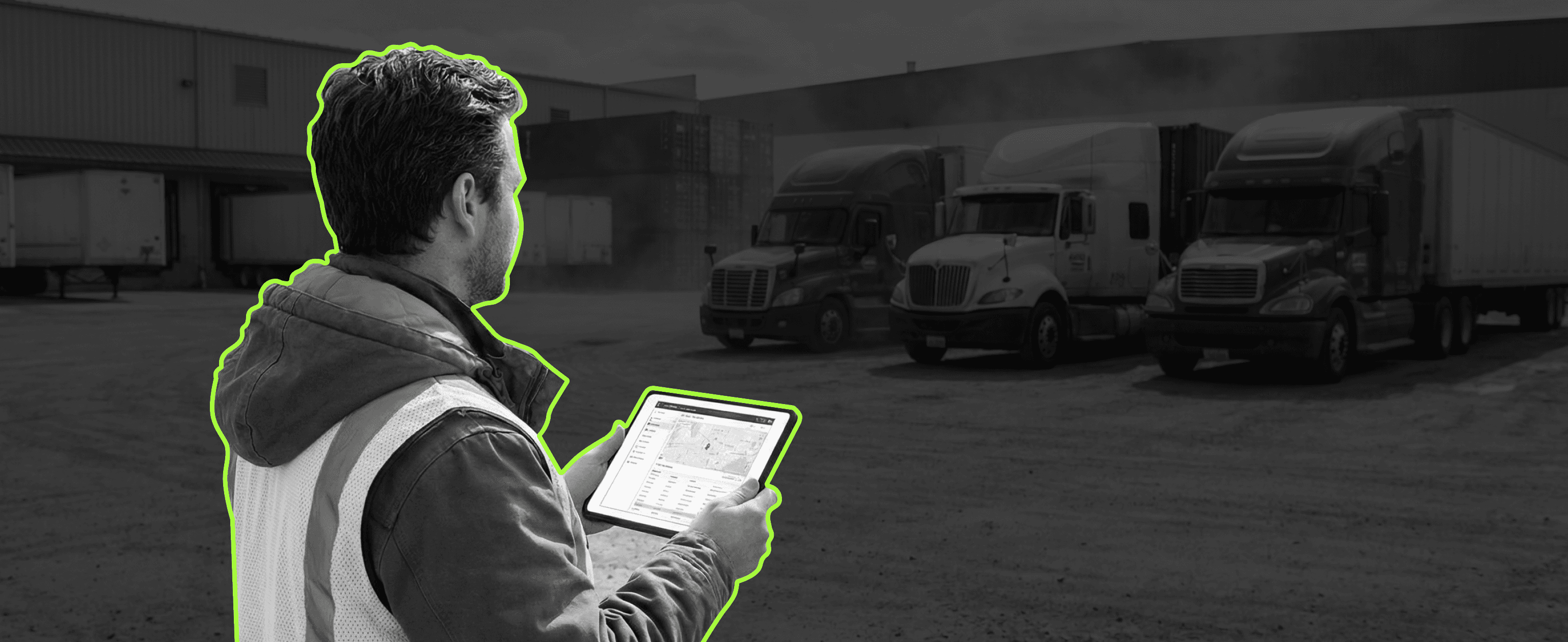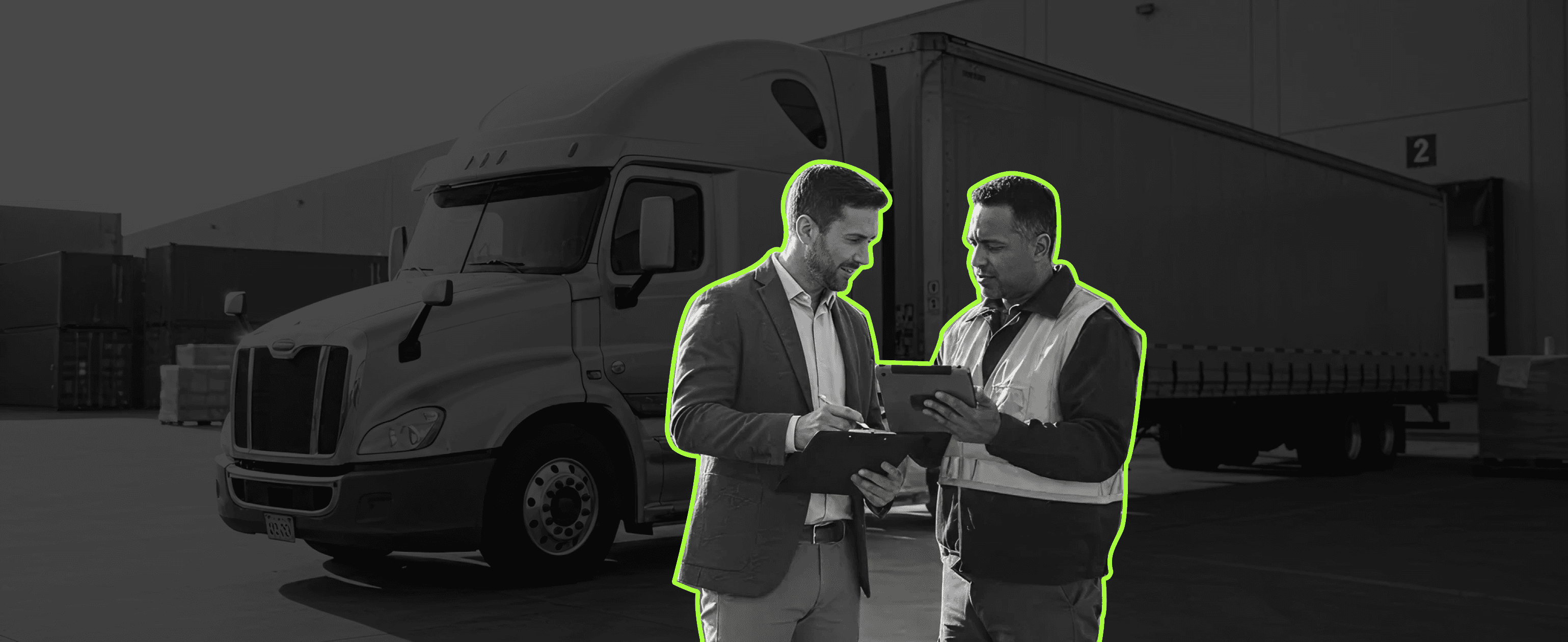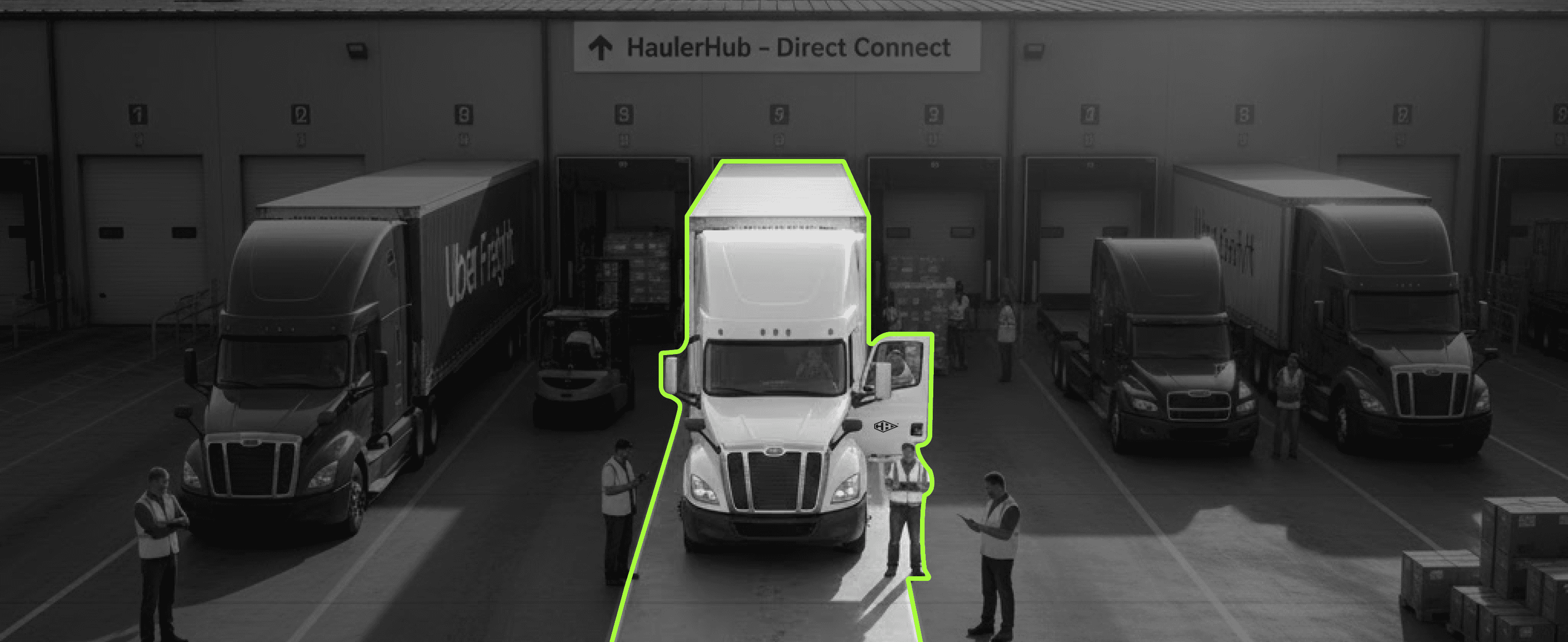Jul 23, 2025
Scroll to explore
While your competitors struggle with outdated supply chains, forward-thinking companies are saving 60-70% on freight costs through smart automation.
Imagine cutting your shipping expenses by more than half while gaining real-time visibility into every shipment. That's not a pipe dream—it's what happens when technology meets modern supply chain management.
Companies using direct shipper-hauler platforms like HaulerHub report transformative results: eliminated broker markups, instant freight matching, and the kind of transparency that turns logistics from a cost center into a competitive advantage.
This guide reveals exactly how to implement process automation that delivers ROI in months, not years—with real examples, actual costs, and proven strategies for every business size.
TLDR: Your 5-Minute Supply Chain Transformation Blueprint
The Big Picture: Smart technology can reduce freight costs by 60-70% while improving speed and accuracy
Key Savings: Eliminate 3PL markups (25-30%) by using direct platforms that charge only 10%
Quick Wins:
Inventory management systems: 99.9% accuracy, 6-month ROI
Warehouse optimization: 50% faster processing, $50K-$200K annual returns
Direct freight connections: Instant quotes, real-time tracking, zero broker fees
Action Steps:
Assess your current supply chain process inefficiencies
Start with one high-impact area (usually transportation or inventory)
Choose automation tools that integrate with existing systems
Measure results and scale what works
Understanding Modern Supply Chain Automation Beyond the Basics
This technology refers to using advanced systems to streamline operations without constant human intervention. This isn't just about robots—it's about intelligent systems that transform how goods move through your network.
Traditional vs. Automated Operations |
Manual Process |
Phone calls for quotes |
Paper BOLs and invoices |
Excel inventory tracking |
Email-based communication |
25-30% broker markups |
Robotic process automation (RPA) now handles repetitive tasks while AI-powered systems automate supply chain decisions that once required hours of analysis. The result? Companies that automate supply processes report 40-70% efficiency gains within the first year.
Key Takeaway: Modern technology isn't about replacing people—it's about empowering them with tools that eliminate friction and unlock growth.
The True Benefits of Supply Chain Automation (With Real Metrics)
The benefits of automation extend far beyond simple cost savings. Here's what companies actually achieve:
Benefit Category | Traditional Operations | With Technology | Impact |
Cost Reduction | 25-30% broker fees | 10% platform fee | 60-70% savings |
Processing Speed | 24-48 hour quotes | Instant matching | 95% faster |
Inventory Accuracy | 85-90% accurate | 99.9% accurate | Near-zero errors |
Visibility | Daily updates | Real-time tracking | 100% transparency |
Compliance | Manual verification | Automated 5-layer checks | 99% fraud reduction |
Warehouse management systems with integrated technology report picking accuracy improvements from 85% to 99.9%. Meanwhile, transportation automation solutions like HaulerHub eliminate the entire broker layer, creating direct connections that improve supply chain efficiency while slashing costs.
Key Takeaway: The right technology delivers compound benefits—saving money while improving speed, accuracy, and customer satisfaction.
Real Supply Chain Automation Examples That Deliver ROI
The global supply chain for manufacturing has been transformed by smart automation systems. Here's how leading manufacturers achieve rapid ROI:
Implementation Stage | Timeline | Investment | Expected Return |
Process Mapping | Weeks 1-2 | $5K-10K | Baseline metrics |
System Selection | Weeks 3-4 | $0 (evaluation) | Vendor comparison |
Pilot Program | Months 2-3 | $50K-100K | 20% efficiency gain |
Full Rollout | Months 4-6 | $200K-500K |
Technology helps manufacturers eliminate bottlenecks across the entire supply chain. Tesla's Gigafactory uses integrated systems that reduce production costs by 30% while maintaining quality standards that manual processes could never achieve.
Action Steps for Manufacturers:
Map your current production flow
Identify top 3 bottlenecks
Start with one automated solution
Measure impact before scaling
Key Takeaway: Focus on automating your supply chain where human error costs the most—typically in inventory tracking and quality control.
Healthcare: Compliance Meets Efficiency

Healthcare organizations face unique challenges across the supply chain, from temperature-sensitive medications to life-critical equipment tracking. Smart technology addresses these while maintaining strict compliance:
Healthcare Use Cases |
Drug temperature monitoring |
Medical device tracking |
Supply reordering |
Compliance reporting |
Key Takeaway: Examples of supply chain automation in healthcare prove that even highly regulated industries can achieve massive efficiency gains without compromising safety.
Food & Beverage: From Farm to Table
The food industry showcases how types of supply chain automation can address perishability and traceability challenges:
Real Implementation Example: A mid-size food distributor invested $75K in technology and achieved:
90% reduction in spoilage through IoT monitoring
Real-time cold chain visibility
Automated FIFO (First In, First Out) management
Direct farmer-to-retailer connections via platforms like HaulerHub
The future of supply chain automation in food service includes blockchain traceability and AI-driven demand forecasting that prevents both waste and shortages.
Key Takeaway: Even small food businesses can implement technology—start with temperature monitoring and digital inventory tracking.
E-commerce and Retail: Competing with Amazon on Any Budget
Technology in the supply chain doesn't require Amazon-level investment. Small retailers using platforms like HaulerHub report immediate benefits:
Direct carrier connections eliminating broker fees
Real-time tracking that customers love
Automated returns processing
Predictive inventory management
Key Takeaway: Start where you hurt most—usually last-mile delivery costs—then expand your automation in logistics and supply operations.
The Complete Supply Chain Automation Toolkit Comparison
Modern automation software for transportation has evolved beyond simple tracking. Here's how different solutions stack up:
Platform Type | Traditional Broker | Digital Freight | HaulerHub Direct |
Markup | 25-30% hidden fees | 15-20% transparent | 10% flat fee |
Quote Speed | 24-48 hours | 2-4 hours | Instant |
Carrier Access | Limited network | Broader network | Unlimited direct |
Visibility | Daily updates | Hourly tracking | Real-time GPS |
Documentation | Manual paperwork | Digital upload | Fully automated |
Communication | Phone/email | In-app messaging | Direct driver chat |
Supply chain data flows seamlessly through modern platforms, providing the supply chain visibility that was once impossible. This transparency alone justifies the switch from traditional brokers.
How Technology Improves Every Link in Your Chain
Automation improves operations by creating intelligent connections between previously siloed systems. This refers to the orchestration of technologies that work together:
Supply chain planning becomes predictive, not reactive
Automation technologies help companies anticipate demand
Real-time data enables instant decision-making
Direct connections eliminate middleman delays
Key Takeaway: The best technology doesn't just digitize old processes—it reimagines how your operations could work.
Overcoming Challenges in Supply Chain Automation
Implementing supply chain automation doesn't mean ripping out existing systems. Smart integration builds on what works while fixing what doesn't:
Integration Challenge | Traditional Approach | Modern Solution | Time to Value |
ERP Connection | 6-month custom coding | API-first platforms | 2 weeks |
Data Migration | Manual transfer + errors | Automated ETL tools | 48 hours |
Team Training | Months of workshops | Intuitive UX + videos | 1 week |
Legacy Systems | Complete replacement | Middleware bridges | 30 days |
Automation examples from successful implementations show that gradual rollouts beat big-bang approaches every time. Companies that handle supply chain tasks incrementally report 90% higher success rates.
Your 30-Day Quick Start Plan:
Week 1: Map current workflows and pain points
Week 2: Connect one system (start with transportation)
Week 3: Train power users and gather feedback
Week 4: Scale to full team and measure impact
Key Takeaway: Technologies like robotic process automation work best when they enhance, not replace, your existing strengths.
Breaking Through Barriers: Real Solutions to Real Problems
Learn how supply chain automation leaders overcome common obstacles:
Challenge 1: Budget Constraints
Solution: Start with high-ROI areas like freight management
Use platforms with usage-based pricing (like HaulerHub's 10% model)
Prove value in one area before expanding
Challenge 2: Change Resistance
Solution: Show, don't tell—pilot programs create believers
Highlight personal benefits (less tedious work, more strategic thinking)
Celebrate early wins publicly
Challenge 3: Technical Complexity
Solution: Choose supply chain management software with strong support
Prioritize user-friendly interfaces
Partner with vendors who handle the heavy lifting
Key Takeaway: Supply chain efficiency improvements come from solving real problems, not implementing technology for its own sake.
Game-Changing Strategies by Company Size
Technology strategies that level the playing field for smaller players. You don't need enterprise resources to achieve enterprise results.
Supply chain systems for small businesses now rival what only Fortune 500s could afford five years ago. Platforms like HaulerHub let you optimize supply operations with zero upfront investment—you only pay when you ship.
Key Takeaway: Start with transportation—it's where small businesses see the fastest, most dramatic savings.
Mid-Market Acceleration: Scale Smart, Scale Fast
Implementing automation at the mid-market level requires balancing ambition with pragmatism. Here's how growing companies handle supply chain tasks without breaking the bank or disrupting operations:
The Mid-Market Advantage:
Agile enough to adapt quickly
Large enough to negotiate better rates
Perfect size for pilot programs
Can implement companies across the supply chain best practices
Real Success Story: A $50M distributor implemented end-to-end technology in phases:
Started with HaulerHub for transportation (60% cost reduction)
Added warehouse systems (40% faster picking)
Integrated predictive analytics (25% inventory reduction)
Total investment: $500K | Annual savings: $2M
Key Takeaway: Mid-market companies have the sweet spot of resources and flexibility—use both to your advantage.
Enterprise Transformation: Leading the Revolution
Disruptors of supply chains aren't always startups. Established enterprises that embrace technology create entirely new competitive moats:
Enterprise Impact Metrics |
Metric |
Order-to-delivery time |
Transportation costs |
Inventory accuracy |
Customer satisfaction |
Carbon footprint |
Automation reduces complexity while increasing capability. Enterprise leaders using modern platforms report that modern supply operations become competitive weapons, not just cost centers.
Key Takeaway: Your role in supply chain leadership means pioneering new approaches—be the disruptor, not the disrupted.
The Future Is Now: Next-Generation Technologies
Supply chain automation makes routine impossible. Here's what's already changing the game:
Emerging Technology | Current Impact | 2025-2027 Projection |
AI Route Optimization | 15% fuel savings | 30% total cost reduction |
Blockchain Tracking | 100% shipment verification | Industry standard |
IoT Sensors | Real-time condition monitoring | Predictive maintenance |
Autonomous Vehicles | Last-mile pilots | 20% of deliveries |
Digital Twins | Virtual testing | Live optimization |
Supply chain automation relies on these technologies working together. When this technology is revolutionizing how goods move, early adopters gain insurmountable advantages.
This involves using multiple technologies in concert. The magic happens when each stage of the supply chain connects seamlessly to the next, creating what technology also enables: a self-optimizing network.
Key Takeaway: The future isn't coming—it's here. Companies using platforms like HaulerHub already access tomorrow's capabilities today.
Sustainability Through Smart Technology
Technology refers to using systems for profit AND planet. Here's how modern solutions deliver both:
Environmental Wins Through Technology:
Route optimization reduces emissions by 25%
Load matching eliminates empty miles
Digital documents save millions of pages
Predictive maintenance prevents breakdowns
Direct connections mean fewer trucks on roads
Your supply chain will need to meet increasing ESG requirements. Automation can be applied to create transparent, auditable sustainability metrics that satisfy stakeholders while saving money.
Key Takeaway: Green transportation isn't just good PR—it's good business. Efficient routes save fuel costs while reducing carbon footprints.
The Truth About Limitations (And Your Workarounds)

Not everything associated with supply chain operations needs technology. Smart leaders know when to enhance human capabilities versus replace them:
Keep Human | Automate Fully | Hybrid Approach |
Complex negotiations | Routine data entry | Customer service |
Relationship building | Invoice processing | Quality control |
Strategic planning | Inventory counts | Exception handling |
Crisis management | Route planning | Demand forecasting |
Understanding limitations of supply chain automation helps you invest wisely. Across the entire supply network, the winning formula combines human creativity with machine efficiency.
Benefits of automation shine brightest when they amplify human strengths rather than eliminate human roles. Companies that move through the supply network with this balanced approach report higher employee satisfaction AND better results.
Key Takeaway: Technology isn't about replacing people—it's about giving them superpowers to focus on what matters most.
Building Resilience Beyond Technology
Manual supply chain operations taught us valuable lessons about flexibility. Modern logistics and supply chain management combines that wisdom with technological capability:
The Resilience Framework:
Automate the predictable
Prepare for the unexpected
Build redundancy into critical systems
Maintain manual override capabilities
Create adaptive response protocols
Throughout the supply chain, resilience comes from smart technology that can flex when needed. Automation can help create anti-fragile systems that get stronger under stress.
Key Takeaway: The best automation refers to the use of technology that enhances adaptability, not rigid systems that break under pressure.
Your Action Plan: From Vision to Victory
Transform your operations with confidence using this proven framework:
Timeline | Focus Area | Key Actions | Success Metrics |
Days 1-30 | Discovery & Quick Wins | • Audit current costs • Try HaulerHub free • Map pain points • Get team buy-in | Baseline established First cost savings |
Days 31-60 | Pilot & Prove | • Launch pilot program • Track all metrics • Gather feedback • Refine approach | 30% efficiency gain Team adoption >80% |
Days 61-90 | Scale & Optimize | • Full deployment • Advanced features • Process refinement • Plan next phase | 50%+ cost reduction ROI documented |
Automation can also create momentum that builds on itself. When teams see real results, adoption accelerates naturally.
Key Takeaway: Success comes from starting smart, proving value fast, and scaling what works.
Making Your Business Case: Data That Drives Decisions
Supply chain automation enables transformative results, but you need the right data to prove it:
ROI Calculation Framework:
Current State Costs:
- Annual freight spend: $_______
- Broker fees (25-30%): $_______
- Manual processing hours: _______ × hourly rate
- Error-related costs: $_______
- Total current cost: $_______
Future State with Technology:
- Platform fees (10% with HaulerHub): $_______
- Reduced labor hours: _______ × hourly rate
- Error reduction savings: $_______
- Total future cost: $_______
Annual Savings = Current Cost - Future Cost
ROI = (Annual Savings / Investment) × 100
Automation uses data to justify itself. Supply chain automation systems that deliver real ROI practically sell themselves to leadership.
Key Takeaway: Automated supply chain systems pay for themselves—usually within 6-12 months.
How HaulerHub Revolutionizes Your Operations Today
Parts of the supply chain that frustrate you most? HaulerHub eliminates them:
Traditional Pain | HaulerHub Solution | Your Benefit |
25-30% broker markups | 10% transparent fee | Save 60-70% on shipping |
24-48 hour quotes | Instant matching | Ship today, not tomorrow |
Phone tag with carriers | Direct driver chat | Real-time communication |
Paper trail nightmares | Digital everything | Complete visibility |
"Where's my truck?" anxiety | Live GPS tracking | Peace of mind |
Fraud and theft risks | 5-layer verification | Protected shipments |
Using automation through HaulerHub means joining a movement that's transforming transportation. Supply chain automation offers more than efficiency—it offers control, transparency, and partnership.
Why Leaders Choose HaulerHub
Automation offers possibilities, but HaulerHub delivers results:
✅ No Upfront Costs: Start saving immediately with our pay-per-use model
✅ Direct Connections: Cut out the middleman, keep the savings
✅ Real Technology: Not just promises—actual tools that work today
✅ Trusted Network: Verified carriers you can count on
✅ 24/7 Support: Real humans, not chatbots, when you need help
✅ Scalable Solutions: From one truck to one thousand, we grow with you
Supply chain automation uses technology to create relationships. With HaulerHub, you're not just a number—you're a partner in revolutionizing transportation.
Key Takeaway: Effective supply chain automation combines powerful technology with human partnership. That's the HaulerHub difference.
Take Control of Your Future Today
Streamline supply operations while slashing costs. Supply chains by automating key processes become competitive advantages. Technology in their supply chains helps industry leaders stay ahead—shouldn't you join them?
Technology makes the complex simple. Traditional supply chain operations hold businesses back, but top supply chain performers know better. They streamline supply chain processes through smart automation of supply chain processes that handle tasks without the friction.
This technology helps you compete, grow, and thrive. Automation reduces what you spend while increasing what you deliver.
Your Next Step Is Simple
Stop wondering how much you could save. Start knowing.
Our free calculator shows your exact savings potential in under 60 seconds. No obligations, no sales calls—just clear data on how HaulerHub's direct connections and transparent pricing transform your bottom line.
Join thousands of shippers and haulers who've already discovered: The future of freight isn't coming—it's here, it's powerful, and it's surprisingly simple.
Ready to revolutionize your operations? Your calculator awaits: haulerhub.com/calculator
Transform transportation. Empower movement. Control your future. That's the HaulerHub way.
Checkout other blogs

Stay ahead of the supply chain.
Break free from costly and complex systems. Sign up with HaulerHub now and make shipping a breeze.




